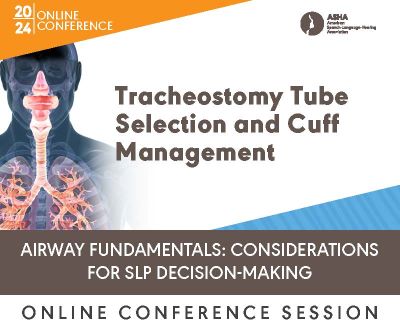ASHA Learning Pass
Log in and check out the Dashboard to view featured courses.

Tracheostomy Tube Selection and Cuff Management (PD103123)
This session is designed for any SLP involved in the inpatient and/or outpatient management for patients who have a tracheostomy tube. The presenter discusses different tube types and their uses, advantages, disadvantages, and manufacturers. The session addresses sizing of tracheostomy tubes and the purpose of inner cannulae and speaking valves, and their relevance to communication and swallowing abilities.
This is a recorded session from a 2024 ASHA online conference, Airway Fundamentals: Considerations for SLP Decision-Making.
Related CoursesSee more sessions from Airway Fundamentals: Considerations for SLP Decision-Making.
Learning
Outcomes
You will
be able to:
- Discuss the different types of tracheostomy tubes
- Identify the advantages and disadvantages of each type of tracheostomy tube
- Explain the impact of downsizing a tracheostomy tube on communication and swallowing
Presenter Information
Priya D. Krishna, MD, MS, FACS (she/her/hers) is an ENT, associate professor, and co-director of the Loma Linda University Voice and Swallowing Center. She did her otolaryngology training at Southern Illinois University and completed a 2-year fellowship in Laryngology and Care of the Professional Voice at the University of Pittsburgh under Clark Rosen, MD, FACS. She received an Earleen Elkins grant and Triologic Society Career Development Award for work in vocal fold scarring and a Casselberry Award from the American Laryngological Association. She has been at Loma Linda since 2011 due to the need for perpetual sunshine. Since that time she has been involved in clinical research in areas of vocal fold atrophy, vocal fold paralysis, behavioral treatment for chronic cough, and esophageal manometry. She is the Chair Elect for the Voice Committee and Immediate Past Chair for the Section of Women in Otolaryngology of the American Academy of Otolaryngology-Head and Neck Surgery.
Disclosures:
- Financial compensation from ASHA for this presentation
Assessment Type
Self-assessment—Think about what you learned and report on the Completion Form how you will use your new knowledge.
To earn continuing education credit, you must complete the learning assessment by 11:59 p.m. ET on the end date below.
Program History and CE Information
Online conference dates: June 5–17, 2024, November 6-18, 2024
End date: July 31, 2030

This course is offered for 0.1 ASHA CEUs (Intermediate level, Professional area).